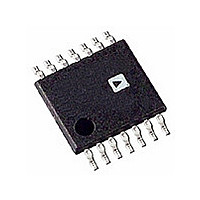AD8343ARU-REEL Analog Devices Inc, AD8343ARU-REEL Datasheet - Page 20

AD8343ARU-REEL
Manufacturer Part Number
AD8343ARU-REEL
Description
IC MIXER ACTIVE HI-IP3 14-TSSOP
Manufacturer
Analog Devices Inc
Series
AD8343r
Datasheet
1.AD8343ARUZ.pdf
(32 pages)
Specifications of AD8343ARU-REEL
Rohs Status
RoHS non-compliant
Rf Type
Cellular, WLAN
Frequency
0Hz ~ 2.5GHz
Number Of Mixers
1
Gain
7dB
Noise Figure
14dB
Secondary Attributes
Up/Down Converter
Current - Supply
60mA
Voltage - Supply
4.5 V ~ 5.5 V
Package / Case
14-TSSOP (0.173", 4.40mm Width)
Operating Temperature (min)
-40C
Operating Temperature (max)
85C
Operating Temperature Classification
Industrial
Lead Free Status / Rohs Status
Not Compliant
Available stocks
Company
Part Number
Manufacturer
Quantity
Price
AD8343
OUTPUT INTERFACE (OUTP, OUTM)
The output of the AD8343 comprises a balanced pair of open
collector outputs. These should be biased to about the same
voltage as is connected to VPOS. Connecting them to an appre-
ciably higher voltage is likely to result in conduction of the ESD
protection network on signal peaks, causing high distortion levels.
On the other hand, setting the dc level of the outputs too low is
also likely to result in poor device linearity due to collector-base
capacitance modulation or saturation of the mixer core transistors.
OUTPUT MATCHING CONSIDERATIONS
The AD8343 requires a differential load for much the same
reasons that the input needs a differential source to achieve
optimal device performance. In addition, a differential load
provides the best LO to output isolation and the best input to
output isolation.
At low output frequencies, it is usually not appropriate to
arrange a conjugate match between the device output and
the load, even though doing so maximizes the small signal
conversion gain. This is because the output impedance at low
frequencies is quite high (a high resistance in parallel with a
small capacitance). See Figure 60 for a plot of the differential
output impedance measured at the device pins. This data is
available in standard file format at the Analog Devices website
(http://www.analog.com); search for AD8343, then click on
AD8343 S-Parameters. If a matching high impedance load is
used, sufficient output voltage swing occurs to cause output
clipping even at relatively low input levels, constituting a loss
of dynamic range. The linear range of voltage swing at each
output pin is about ±1 V from the supply voltage VPOS. A
good compromise is to provide a load impedance of about
200 Ω to 500 Ω between the output pins at the desired output
frequency (based on 15 mA to 20 mA bias current at each
input). At output frequencies below 500 MHz, more output
power can be obtained before the onset of gross clipping by
using a lower load impedance; however, both gain and low
order distortion performance can be degraded.
Figure 60. Output Differential Impedance (OUTP, OUTM)
FREQUENCY (50MHz TO 2500MHz)
2000MHz
1500MHz
1000MHz
500MHz
50MHz
Rev. B | Page 20 of 32
The output load impedance must also be kept reasonably low
at the image frequency to avoid developing appreciable extra
voltage swing, which can reduce dynamic range.
If maintaining a good output return loss is not required, a 4:1 to
8:1 (impedance) flux-coupled transformer can be used to present a
suitable load to the device and to provide collector bias via a
center tap as shown in Figure 69. At all but the lowest output
frequencies, it becomes desirable to tune out the output capaci-
tance of the AD8343 by connecting an inductor between the
output pins. On the other hand, when a good output return loss
is desired, the output can be resistively loaded with a shunt
resistance between the output pins in order to set the real value
of output impedance. With selection of both the transformer’s
impedance ratio and the shunting resistance as required, the
desired total load (~500 Ω) is achieved while optimizing both
signal transfer and output return loss.
At higher output frequencies, the output conductance of the
device becomes higher (see Figure 60), with the consequence
that above about 900 MHz, it does become appropriate to
perform a conjugate match between the load and the AD8343s
output. The device’s own output admittance becomes sufficient
to remove the threat of clipping from excessive voltage swing.
Just as for the input, it is best to perform differential output
impedance measurements on the board layout to effectively
develop a good matching network.
OUTPUT BIASING CONSIDERATIONS
When the output single-ended-to-differential conversion takes
the form of a transformer whose primary winding is center
tapped, simply apply VPOS to the tap, preferably through a
ferrite bead in series with the tap in order to avoid a common
mode instability problem (see the Input and Output Stability
Considerations section). See Figure 69 for an example of this
network. The collector dc bias voltage must be nominally equal
to the supply voltage applied to Pin 5 (VPOS).
If a 1:1 transmission line balun is used for the output, it is
necessary to bring in collector bias through separate inductors.
These inductors are chosen to obtain a high impedance over
the RF output frequency range of interest. See Figure 70 for an
example of this network.
















